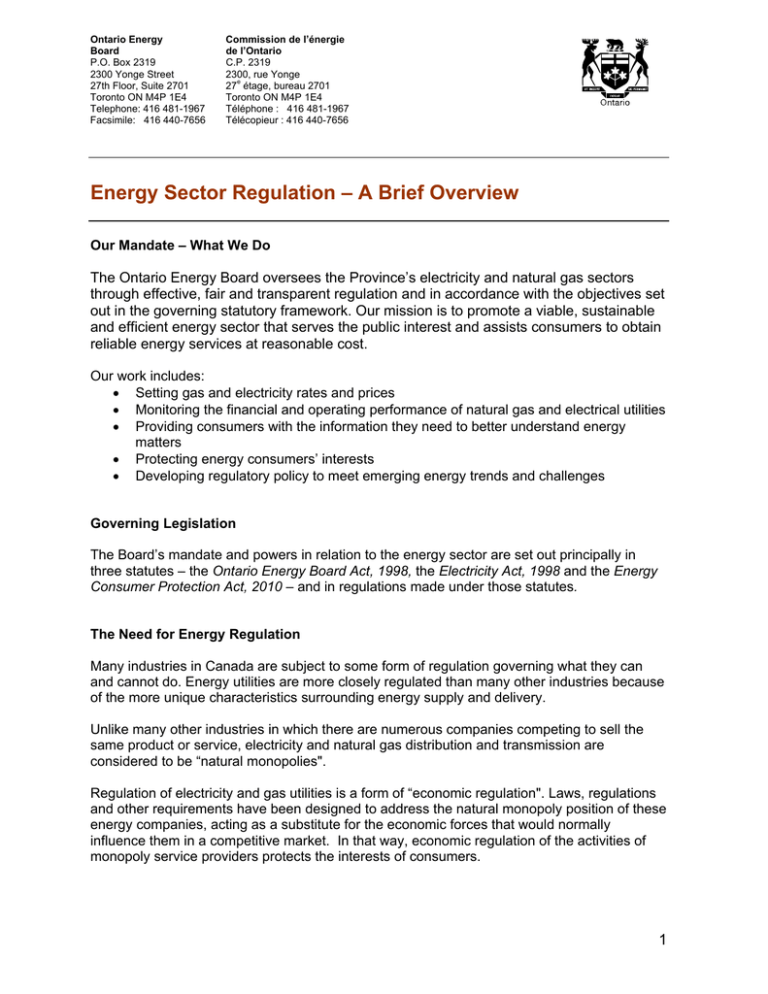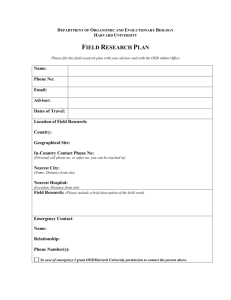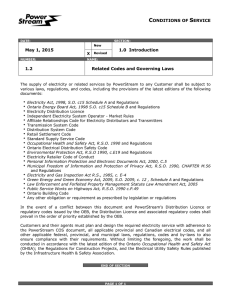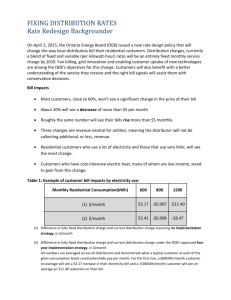Energy Sector Regulation – A Brief Overview
advertisement

Ontario Energy Board P.O. Box 2319 2300 Yonge Street 27th Floor, Suite 2701 Toronto ON M4P 1E4 Telephone: 416 481-1967 Facsimile: 416 440-7656 Commission de l’énergie de l’Ontario C.P. 2319 2300, rue Yonge e 27 étage, bureau 2701 Toronto ON M4P 1E4 Téléphone : 416 481-1967 Télécopieur : 416 440-7656 Energy Sector Regulation – A Brief Overview Our Mandate – What We Do The Ontario Energy Board oversees the Province’s electricity and natural gas sectors through effective, fair and transparent regulation and in accordance with the objectives set out in the governing statutory framework. Our mission is to promote a viable, sustainable and efficient energy sector that serves the public interest and assists consumers to obtain reliable energy services at reasonable cost. Our work includes: Setting gas and electricity rates and prices Monitoring the financial and operating performance of natural gas and electrical utilities Providing consumers with the information they need to better understand energy matters Protecting energy consumers’ interests Developing regulatory policy to meet emerging energy trends and challenges Governing Legislation The Board’s mandate and powers in relation to the energy sector are set out principally in three statutes – the Ontario Energy Board Act, 1998, the Electricity Act, 1998 and the Energy Consumer Protection Act, 2010 – and in regulations made under those statutes. The Need for Energy Regulation Many industries in Canada are subject to some form of regulation governing what they can and cannot do. Energy utilities are more closely regulated than many other industries because of the more unique characteristics surrounding energy supply and delivery. Unlike many other industries in which there are numerous companies competing to sell the same product or service, electricity and natural gas distribution and transmission are considered to be “natural monopolies". Regulation of electricity and gas utilities is a form of “economic regulation". Laws, regulations and other requirements have been designed to address the natural monopoly position of these energy companies, acting as a substitute for the economic forces that would normally influence them in a competitive market. In that way, economic regulation of the activities of monopoly service providers protects the interests of consumers. 1 Balancing Consumer and Utility Interests As a regulator, the OEB balances the interests of consumers and utilities. Consumers are well served if both the pricing and the standard of service being provided are fair and reasonable. In this regard, the OEB’s mandate includes setting distribution and transmission rates that are “just and reasonable” and establishing standards and conditions of service for utilities to follow in their operations. Utilities are well served if they are financially viable businesses. Utilities must have a reasonable opportunity to recoup costs and earn a fair return for the significant financial investment they make in order to supply and deliver energy to consumers. Regulating Ontario’s Energy Sector – How We Do It The Ontario Energy Board is committed to continually improving our regulatory processes to ensure that they are effective, fair and transparent. The OEB consults widely with consumer groups and other stakeholders in the natural gas and electricity sectors to ensure that we understand the issues, concerns and priorities of those we serve and regulate. Our role as regulator of the energy sector includes: Setting just and reasonable rates One of the OEB’s principal functions is to set “just and reasonable rates” that utilities may collect from ratepayers for utility services. The Board sets rates using a quasi-judicial process that requires utilities to present evidence to justify any proposed rate increases through an open and transparent public hearing. The OEB’s current rate-setting process establishes base rates for each distribution utility through a comprehensive review of the utility’s costs as detailed in its rate application. This review currently occurs every four years for electricity distributors and every five years for natural gas distributors. In the intervening years, the Board provides for inflationary increases adjusted by a productivity measure. Establishing requirements for service quality and conduct To protect consumers and other participants in the energy sector, the OEB has imposed a number of responsibilities and obligations on entities operating in the energy sector. For example, the OEB has established minimum standards for the operation of electricity distribution and transmission systems, requirements for connecting to those systems, and standards for the quality of service to be provided to consumers by electricity and gas distributors. Electricity retailers and natural gas marketers are required to follow Codes of Conduct developed by the OEB. Monitoring Compliance The OEB conducts audits, carries out compliance inspections and examines allegations of non-compliance to ensure that regulated entities are complying with their legal and regulatory obligations. The Board can undertake enforcement action where appropriate if a regulated entity is not in compliance. 2 Monitoring Financial Viability The OEB maintains ongoing oversight of the financial viability of regulated utilities. To assist in that activity, electricity and natural gas distributors are required to file financial data with the OEB. Annually, the OEB publishes a statistical Yearbook on its web site that provides the financial and service quality results for each regulated distributor for the preceding year, to provide transparency on each distributor’s performance. Protecting Consumers Increasing Consumer Awareness To help the public better understand energy matters and make informed energy decisions, the OEB provides a broad range of information about electricity and natural gas in Ontario through its dedicated consumer website, consumer education campaigns and province-wide community outreach programs. Using the OEB’s online interactive bill calculator, consumers can estimate their monthly utility bill and see what their bill might look like based on the prices being offered by an electricity retailer or natural gas marketer. Investigating Complaints The OEB provides assistance to consumers who are experiencing service issues they could not resolve directly with their energy supplier. Enhancing Customer Service Rules The OEB has developed enhanced customer services rules that electricity utilities must follow. These rules are designed to ensure the consistent and fair treatment of electricity consumers across Ontario, regardless of who their electricity distributor is. In addition, we have reviewed the customer service practices of natural gas utilities including those specifically tailored to low-income natural gas consumers. Protecting Consumers in the Retail Markets The OEB protects the interests of consumers by regulating the conduct of entities that offer retail energy contracts to residential and small business electricity and natural gas consumers in Ontario. This includes: Licensing electricity retailers and gas marketers Requiring that they follow fair business practices Monitoring and, where appropriate, enforcing compliance so that electricity retailers and gas marketers are accountable if they do not follow their legal or regulatory obligations Helping low-income energy consumers The OEB has, with the assistance and cooperation of utilities, social agencies, consumer groups and other energy sector participants, developed programs and rules to help low-income energy consumers better manage their bill payments and energy costs, including: LEAP emergency financial assistance, which provides year-round emergency financial assistance to qualified low-income energy consumers who are having difficulty paying their bills. This assistance helps avoid disconnection. To assist consumers with limited financial resources, the OEB has put in place customer service rules specifically for eligible low-income electricity customers. For example, these customers can have more flexibility regarding security deposits and more time to pay outstanding bills. 3 Licensing Licensing is another important tool the OEB uses to protect energy consumers. The OEB licenses natural gas marketers who sell to low-volume consumers (residential and small commercial consumers), as well as most participants in the electricity sector (generators, transmitters, distributors, wholesalers, retailers, unit sub-metering providers, the Independent Electricity System Operator, the Ontario Power Authority and the Smart Metering Entity). A licence from the OEB provides these entities with permission to operate and outlines their regulatory requirements. Monitoring Electricity Markets The Market Surveillance Panel (a panel of the Ontario Energy Board), monitors the wholesale electricity market to identify inappropriate or unusual conduct by market participants and actual or potential design flaws and inefficiencies in the structure of the market and the market rules. The Panel’s reports on its monitoring efforts include recommendations for mitigating the unusual conduct, flaws, and inefficiencies it identifies. The Panel may conduct investigation into any activities related to the IESO-administered markets or the conduct of a market participant, and prepare a report including any findings and recommendations upon completion of each investigation. 4




